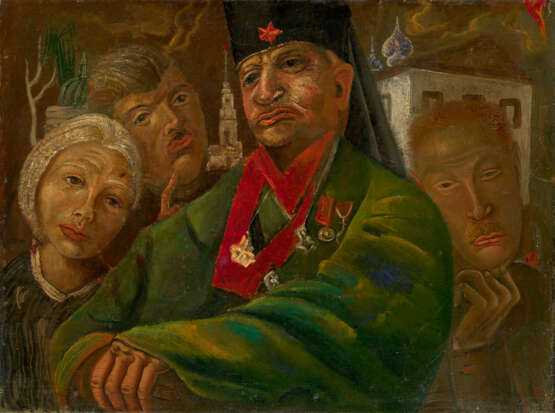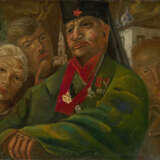ID 412535
Lot 43 | Red Army General
Valeur estimée
£ 80 000 – 120 000
Provenance: Private collection, Europe.
Authenticity of the work has been confirmed by the expert I. Vakar.
Red Army General, presented here for auction, was painted by Boris Grigoriev in the 1930s, and is seen now as a continuation of his celebrated series Visages de Russie, which he had produced a decade earlier in Paris. After that period, Grigoriev worked in Europe and the USA and taught in Latin America — everywhere with a success that was extraordinary for a Russian émigré artist.
Wherever he was, even in the 1930s, he never abandoned his Russian themes, adding to his Visages de Russie series the canvas frieze Characters from Gogol’s Play “The Government Inspector” (1933–1935), and Red Army General. Logically expanding the artistic formula that he had devised back in Russia in the Rasseya series, Grigoriev treats these late images in a deliberately grotesque manner. Although all the characters in the present work were originally based on real prototypes, they were distorted under the artist’s hand with such expressiveness that they acquired the features of surreal, ghost-like masks.
Freed from all incidental detail, Grigoriev’s Red Army General becomes a symbol of Soviet Russia as seen from afar, bearing the imprint of Bolshevik terror and degradation. The general is one of Alexander Blok’s twelve apostles of the Revolution, standing in the centre of the composition in a red-starred cowl, leading his country towards the new Communist faith. His comrades and brothers-in-arms stand on either side. In the distance, there is an edifice resembling something between the bell-tower of the Peter and Paul Cathedral (shrine of the Imperial House of Romanov) and a Kremlin tower, its spire crowned with a red star: a cupola without crosses. Overhead, “their red flag strikes the watchful eye” (A. Blok, The Twelve).
Grigoriev significantly enlarges the characters’ faces, placing them against a symbolic background delineated in only a few strokes and lining them up in silent expectation at the very edge of the canvas. Thus, the central hero, who bears a distinct resemblance to the Soviet commander Mikhail Tukhachevsky, dubbed “the red Bonaparte”, and his stiff, lifeless companions may appear isolated from the background yet, rhythmically, are fully integrated into the composition.
The combination of a large-scale foreground configuration (sharply cropped, zoomed-in and fixed, as in a photograph) with a symbolical architectural landscape in the background is a compositional method Grigoriev had used in his portraits as early as 1916–1917, and then applied consistently in Rasseya, Visages de Russie and other works of the 1920s. However, in the picture Red Army General, the sombre, expressionist, and explicitly primitivist treatment of the subject, the economy of form and the simplicity of colour resonances enable the artist to eschew repetitiveness in referencing his own, previously devised images and sculptural forms.
The “shadow of Rasseya”, as Alexander Benois put it, was cast over all Grigoriev’s later work, including Red Army General. We can therefore regard this distinctive picture as one of the last Visages de Russie conceived by the artist. Red Army General is a development and to some extent the culmination of the series. It embodies, as Gleb Pospelov rightly says, an image of the Motherland that is “if not more joyful, then certainly deeper and more multi-faceted than that of Rasseya”.
| Artiste: | Boris Grigoriev (1886 - 1939) |
|---|
| Artiste: | Boris Grigoriev (1886 - 1939) |
|---|
| Adresse de l'enchère |
MacDougall Arts Ltd. 33 St James’s Square SW1Y 4JS London Royaume-Uni | ||||||||||||||
|---|---|---|---|---|---|---|---|---|---|---|---|---|---|---|---|
| Aperçu |
| ||||||||||||||
| Téléphone | +44 20 7389 8160 | ||||||||||||||
| Téléphone | +7 495 799 4683 | ||||||||||||||
| Fax | +44 (0) 20 7389 8170 | ||||||||||||||
| Commission | 27 % | ||||||||||||||
| Conditions d'utilisation | Conditions d'utilisation | ||||||||||||||
| Heures d'ouverture | Heures d'ouverture
|











